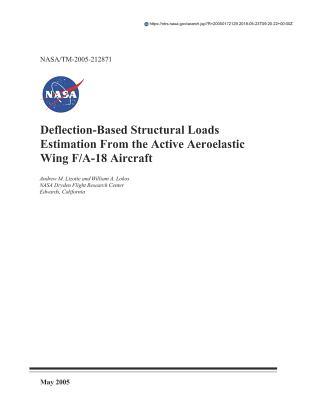Read online Deflection-Based Structural Loads Estimation from the Active Aeroelastic Wing F/A-18 Aircraft - National Aeronautics and Space Administration file in ePub
Related searches:
Deflection-Based Structural Loads Estimation From the Active
Deflection-Based Structural Loads Estimation from the Active Aeroelastic Wing F/A-18 Aircraft
Why the deflection of concrete beam is calculated according to
The Mathematics of Simple Beam Deflection
Graph for determining tapered beam size based on deflection under uniformly distributed load.
Ultimate load is a has a rare probability of occurrence in a structure. Service load deflection for concrete beams is based upon the moment of inertia.
Loads, on the other hand, affect the beam's deflection in two ways: the direction of the deflection and the magnitude of the deflection. Loads can be in the form of a single point load, linear pressure, or moment load.
During an extreme seismic event, the code-based structure is expected to maintain its load-carrying capacity for gravity loads even after the structure deforms.
Beam shall be checked for the vertical deflection considering the imposed loads applied on the beam. Table 8 of bs 5950: 2000 indicates the limiting values to be considered for the design. Deflection due to the design loads could be calculated manually or it could be obtained from the analysis.
5 nov 2020 deflection is a crucial consideration in the design of a structure and failure to apply due attention to it can be catastrophic.
Distributed, (b)concentrated load, (c)combination of uniformly and distributed, (d)two equally concentrated loads and a(e) cantilever with concentrated load at a free-end as shown below. (a)uniformly distributed loads a uniform distributed load is a distributed load that has a constant value, (example 1lb/ft).
The contrastive investigation is carried out to illustrate the influence of axial load on the variation pattern of impact force for cfst members under various structural.
The tables below give equations for the deflection, slope, shear, and moment along straight beams for different end conditions and loadings. You can find comprehensive tables in references such as gere, lindeburg, and shigley.
Deflection-based structural loads estimation from the active aeroelastic wing f/a-18 aircraft traditional techniques in structural load measurement entail the correlation of a known load with strain-gage output from the individual components of a structure or machine. The use of strain gages has proved successful and is considered the standard.
While a particular structural design is required to satisfy the ibc, as well as material ibc and asce/sei 7, minimum design loads for buildings and other structures, deflections based on ratios of span length consider the maximum.
The direction of the jump is the same as the sign of the point load. Uniform distributed loads result in a straight, sloped line on the shear diagram. The slope of the line is equal to the value of the distributed load.
Deflection-based aircraft structural loads estimation load with strain-gage output from the individual components of a structure or machine.
In engineering, deflection is the degree to which a structural element is displaced under a load (due to its deformation).
Stiffness of structural members is limited by maximum allowable deflection. In other words, how much a joist or rafter bends under the maximum expected load. Only live loads are used to calculate design values for stiffness.
Allowable deflection is generally expressed as a fraction of the span, in inches. The amount of flex depends on the magnitude of the load applied, span of the member, and stiffness of the member.
Maximum allowable deflection in concrete beams and slabs needs to be limited as per the serviceability requirements specified in the design standards. The limiting values have been given based on the span or the span and effective depth ratio. The value of the limiting deletion for slabs and beams are more similar.
Deflection is the displacement within a structural member under the influence of loads, ignoring the displacements of the rest of the structure. There are generally a few main components which make a crucial influence on the magnitude of beam deflection: beam member span (unsupported length of the beam member);.
A structure capable of resisting all applied loads without accumulated knowledge based on field and model tests, permissible deflection of the structure.
15 may 2020 all structural members will deflect or flex under load. Note it gives the allowable deflection based on a fractional span quantity, so a larger.
Beams are the long members of a structure that carry the loads brought by the horizontal slabs of the structures, including floors and roofs. When beams carry loads that are too heavy for them, they start to bend.
For the frp/aac panels tested in this study (two-point load, one-third span with simply supported the parameter λ is determined experimentally based on the deflection.
Loads come from material weights, people, and the environment. This area is assumed to be from half the distance to the next beam over to halfway to the next beam. The reactions must be supported by the next lower structural element ad infinitum, to the ground.
Short-term deflections of beams and one-way slabs occur immediately on the application of load to a structural member.

Post Your Comments: